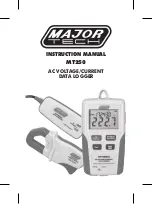
Pro II: Extension and Interface Modules
Pro II-CAN-2 Rev. E
ADwin
158
ADwin-Pro II
Hardware, manual Dec. 2018
5.8.4 Pro II-CAN-2 Rev. E
The module Pro II-CAN-2 Rev. E has 2 CAN interfaces, a high speed or a low
speed version. The names for the module versions are:
– Pro II-CAN-2 Rev. E: CAN interface high speed
– Pro II-CAN-2-LS Rev. E: CAN interface low speed
Each module is equipped with a freely programmable
TiCo
processor, which
has full access to the CAN interfaces. Find more information about use and
programming of the
TiCo
processor in the
TiCoBasic
manual.
The manual is divided into the following sections:
– TiCo processor
– Enable Interrupt / Trigger Event
CAN Controller
The CAN bus interface is equipped with the Intel
®
CAN controller AN82527,
which works according to the specification CAN 2.0 parts A and B as well as
to ISO 11898. You program the interface with
ADbasic
instructions, which are
directly accessing the controller’s registers.
Message
Messages sent via CAN bus are data telegrams with up to 8 bytes, which are
characterized by so-called identifiers. The CAN controller supports identifiers
with a length of 11 bit and 29 bit. The communication, that means the manage-
ment of bus messages, is effected by 15 message objects.
The registers are used for configuration and status display of the CAN control-
ler. Here the bus speed and interrupt handling, etc. are set (see separate doc-
umentation "82527 - Serial Communications Controller, Architectural Over-
view" by Intel
®
)
The CAN bus can be set to frequencies of up to 1 MHz and is usually operated
with 1MHz; with low speed CAN the max. frequency is 125kHz. The CAN bus
is galvanically isolated by optocouplers from the
ADwin
system.
An arriving message can trigger an interrupt, which instantaneously generates
an event at the processor. Therefore, an immediate processing of messages
is guaranteed.
TiCo processor
The module provides the freely programmable
TiCo
processor with 28KiB pro-
gram memory, and 28KiB data memory. The
TiCo
processor has access to the
CAN controller. Find more information about use and programming of the
TiCo
processor in the
TiCoBasic
manual.
If you store a
TiCoBasic
program in the
TiCo
bootloader, the program is auto-
matically loaded into the
TiCo
processor and started on power-up. Thus, the
module can run on its own and independently from the CPU module of the
ADwin-Pro II
system.















































